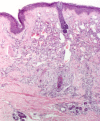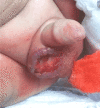Morphological, genetic and clinical correlations in infantile hemangiomas and their mimics
- PMID: 33817710
- PMCID: PMC8112746
- DOI: 10.47162/RJME.61.3.07
Morphological, genetic and clinical correlations in infantile hemangiomas and their mimics
Abstract
Infantile hemangiomas (IHs) are the most frequent pediatric benign vascular tumors, with a reported incidence of 5% to 10%. They have self-limiting evolution pattern divided into a growth phase in the first 12 months and a regression one, that may take up to 10 years. Occasionally, hemangiomas might lead to local or systemic complications, depending on their morphological characteristics. The first line of treatment is β-blockers, such as Propranolol, Timolol, Nadolol, administered either locally or systemically. Newer therapeutic strategies involving laser therapy and angiotensin-converting enzyme inhibitors are being studied, while older treatment modalities like corticosteroids, Imiquimod, Vincristine, Bleomycin and Interferon-α have become second line therapy options. Before establishing the appropriate treatment, clinical, histological, and imaging investigations are required.
Conflict of interest statement
The authors declare that they have no conflict of interests.
Figures










Similar articles
-
Current treatment and management of infantile hemangiomas.Surv Ophthalmol. 2019 Sep-Oct;64(5):608-618. doi: 10.1016/j.survophthal.2019.02.005. Epub 2019 Feb 14. Surv Ophthalmol. 2019. PMID: 30772366 Review.
-
Propranolol-resistant infantile hemangioma successfully treated with sirolimus.Pediatr Dermatol. 2020 Jul;37(4):684-686. doi: 10.1111/pde.14163. Epub 2020 Apr 23. Pediatr Dermatol. 2020. PMID: 32323340
-
Nadolol for the treatment of infantile hemangioma.Am J Health Syst Pharm. 2015 Jan 1;72(1):44-6. doi: 10.2146/ajhp140097. Am J Health Syst Pharm. 2015. PMID: 25511837
-
Multiple pulmonary infantile hemangiomas responsive to oral propranolol.Pediatr Dermatol. 2021 Jan;38(1):226-228. doi: 10.1111/pde.14413. Epub 2020 Nov 6. Pediatr Dermatol. 2021. PMID: 33155718
-
Beta blocker treatment for infantile hemangiomas.Dermatol Online J. 2015 Jul 15;21(7):13030/qt05k4t1hq. Dermatol Online J. 2015. PMID: 26436966 Review.
Cited by
-
Clinical and Pathological Profile of Children and Adolescents with Osteosarcoma.Diagnostics (Basel). 2025 Jan 23;15(3):266. doi: 10.3390/diagnostics15030266. Diagnostics (Basel). 2025. PMID: 39941196 Free PMC article.
-
The Role of Natural Extracts in the Management of Infantile Hemangiomas and Vascular Tumors.Pediatric Health Med Ther. 2024 Jan 6;15:1-16. doi: 10.2147/PHMT.S439537. eCollection 2024. Pediatric Health Med Ther. 2024. PMID: 38213420 Free PMC article. Review.
-
Early Presentation of an Ulcerated Infantile Haemangioma in a Newborn.Cureus. 2022 Jan 24;14(1):e21545. doi: 10.7759/cureus.21545. eCollection 2022 Jan. Cureus. 2022. PMID: 35223318 Free PMC article.
-
Atypical development and swift resolution of an ulcerated hemangioma: a case report.J Med Case Rep. 2025 Jul 18;19(1):352. doi: 10.1186/s13256-025-05422-9. J Med Case Rep. 2025. PMID: 40682105 Free PMC article.
-
Infantile Hemangioma Mimics Dermatofibrosarcoma Protuberans.Eplasty. 2024 Apr 18;24:e20. eCollection 2024. Eplasty. 2024. PMID: 38846498 Free PMC article.
References
-
- Schupp CJ, Kleber JB, Günther P, Holland-Cunz S. Propranolol therapy in 55 infants with infantile hemangioma: dosage, duration, adverse effects, and outcome. Pediatr Dermatol. 2011;28(6):640–644. - PubMed
-
- Frieden IJ, Püttgen KB, Drolet BA, Garzon MC, Chamlin SL, Pope E, Mancini AJ, Lauren CT, Mathes EF, Siegel DH, Gupta D, Haggstrom AN, Tollefson MM, Baselga E, Morel KD, Shah SD, Holland KE, Adams DM, Horii KA, Newell BD, Powell J, McCuaig CC, Nopper AJ, Metry DW, Maguiness S, Hemangioma Investigator Group Management of infantile hemangiomas during the COVID pandemic. Pediatr Dermatol. 2020;37(3):412–418. - PMC - PubMed
-
- Hoeger PH, Harper JI, Baselga E, Bonnet D, Boon LM, Ciofi Degli Atti M, El Hachem M, Oranje AP, Rubin AT, Weibel L, Léauté-Labrèze C. Treatment of infantile haemangiomas: recommendations of a European expert group. Eur J Pediatr. 2015;174(7):855–865. - PubMed
-
- Léauté-Labrèze C, Dumas de, Hubiche T, Boralevi F, Thambo JB, Taïeb A. Propranolol for severe hemangiomas of infancy. N Engl J Med. 2008;358(24):2649–2651. - PubMed
MeSH terms
Substances
LinkOut - more resources
Full Text Sources
Other Literature Sources
Medical

